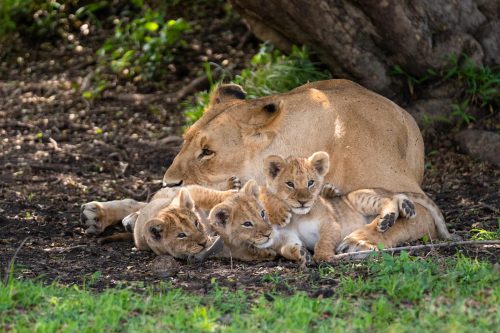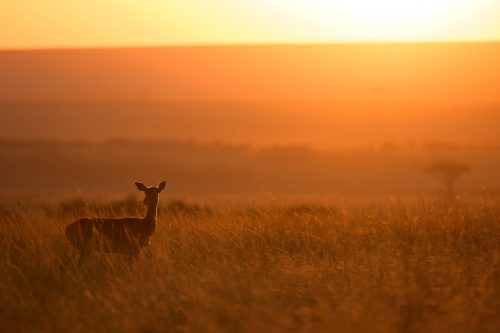Leopards have similar mating rituals to lions — lasting up to five days and mating approximately every 15 minutes for only a few seconds. This week, we saw Osidai and Nakwet together but what's unusual about this pair is that we have observed them mating for over a month, well over the expected period.
Mating, or 'jiggy jiggy' as we call it, starts fairly calmly with soft growls as the female approaches the male entering his personal space and starts seducing him by rubbing her tail over him. As the copulation initiates, he bites the nape of her neck — an act to ensure her submission. The male’s penis is barbed, a trait found in most felines, which helps induce ovulation in females.
However, as he withdraws, it becomes painful and in this instance Nawket spun around, lashing out with her sharp claws aimed at his face. Anticipating this, Osidai leapt away and moved off as she flopped over and rolled on her back. We're hoping all of this prolonged action will produce some beautiful new cubs as we have not seen one of our favourite leopards, Nadallah, in quite some time and are beginning to fear the worst.
In last week's blog, we reported that Risasi’s boys had eventually separated from their mother, the two being alone for the first time after 16 months under her care. Cheetahs have the lowest survival rate of all cats and with the odds stacked against them in the challenge for resources, when you see one in the wild, you know it's a true survivor.
Sadly, on 27 September, the Mara Conservancy, in conjunction with vets from David Sheldrick Wildlife Trust and Kenya Wildlife Service rangers, reported the death of one of the boys. In their report, they indicated that the two brothers were hunting when one of the boys got a spinal injury with a penetrating puncture wound going all the way through to the thoracic cavity. This caused a pneumothorax, haemorrhage and collapse of the lungs — resulting in his death shortly after the injury. This is a terrible loss and even more so for the remaining lone brother. His chance of survival now, solo and at such a young age, is very slim.
Female cheetahs lead mostly solitary lives, unlike the males who prefer living in set territories and in small coalitions. Recently separating from her boys, Risasi was seen successfully taking down a baby Thomson's gazelle by herself and chowing down on it fairly quickly, so as not to attract unwanted attention. Knowing what and when to hunt has made this lone female a very successful predator. Perhaps she will mate again soon and grace us with another litter of cubs.
In more cheetah headlines, there is a new male in the Triangle spotted by our beloved guest, Katie Brauer. This solitary, fairly young male, came from the Serengeti and was seen in the Sausage Tree Pride territory. Hopefully, the odds here will be in his favour and he'll stay in the Triangle.
Speaking of the Sausage Tree Pride, they appear to be thriving. The pride is now 11-strong with the addition of the two Lamai males providing them with protection. At the moment, Kinky Tail is still keeping apart from the pride while she mates with one of the males.
Elephants are known to form intimate bonds between friends and family members and these bonds are even stronger between mothers and their calves. We found these four elephants lagging behind the rest of the herd at a drinking spot, quenching their thirst and enjoying a mud bath in the heat of the day. On a closer look, we noticed the small calf was very tiny, clearly a newborn and still very wobbly on its feet. Unable to move quickly, the two older siblings stayed with their mother and her newborn, refusing to keep up with the rest of the herd. Ever so patient and gentle, they all kept nudging the baby forward while sticking together.
As the rains continue, the Triangle is transformed with beautiful greenery all around. These baby elephants were having a great time playing with each other amidst the fresh green grass.
In an intriguing sighting, Angama Guide, Eric Lemaalo, came across an unknown older female leopard in the Triangle. She was trapped up in a tree with lions standing guard below. While the shy leopard wasn't keen on sticking around for a photo op, thanks to the lions, she did manage to strike a pose in the tree.
While the herds from the Great Migration have pretty much mowed their way through the Triangle, the wildebeest have disappeared earlier than expected. With the rains, the plains have transformed into endless hues of green without the herds to chew them down. These animals, however, are unpredictable and motivated by grass so we will wait and see what happens after the sprouting of lush soft grass.

Just a year ago, we were introduced to the three newest additions to the Sausage Tree Pride. It's hard to believe how much they have grown in a year, overly big paws and all.
Filed under: This Week at Angama
Subscribe for Weekly Stories
Comments (0):

Rates & Availability